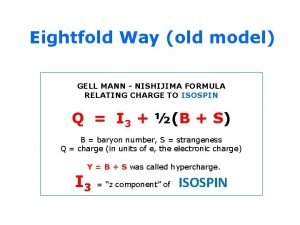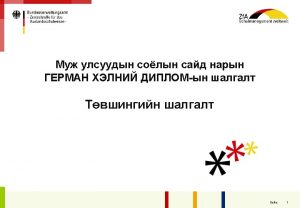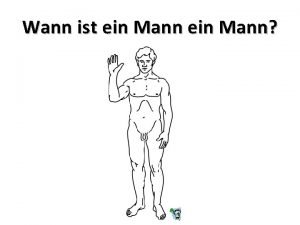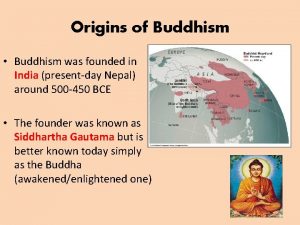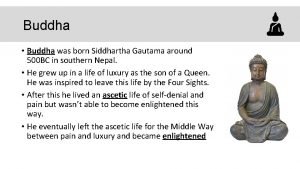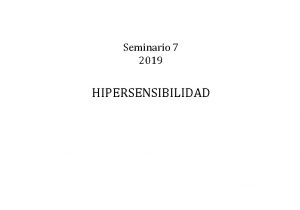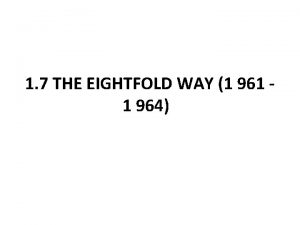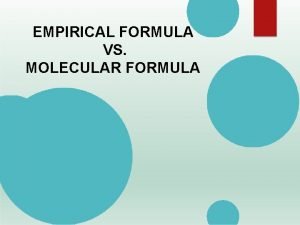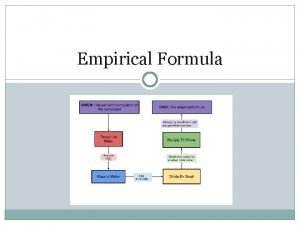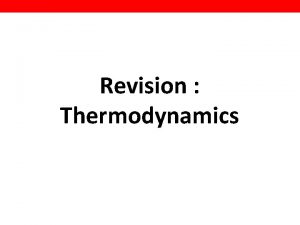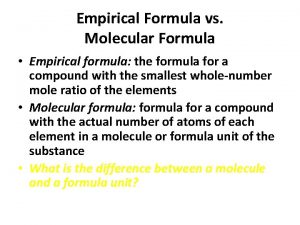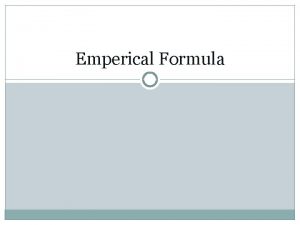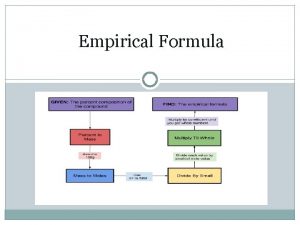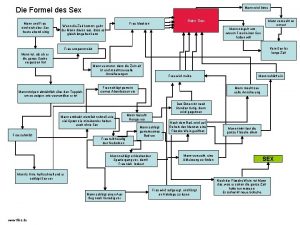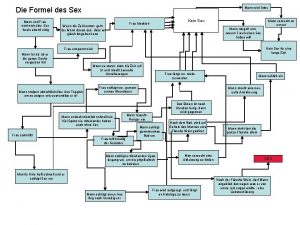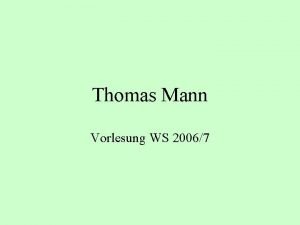Eightfold Way old model GELL MANN NISHIJIMA FORMULA




















- Slides: 20

Eightfold Way (old model) GELL MANN - NISHIJIMA FORMULA RELATING CHARGE TO ISOSPIN Q = I 3 + ½(B + S) B = baryon number, S = strangeness Q = charge (in units of e, the electronic charge) Y = B + S was called hypercharge. I 3 = “z component” of ISOSPIN

Iso-Spin It was discovered that particles with approximately the same mass, and the same (ordinary) spin existed in “charge multiplets”: p and n I 3 = ½, - ½ (a doublet) ∏+ ∏- ∏ 0 I 3 = 1, -1, 0 (a triplet) number of states = 2 I +1

Mass (Me. V/c 2) Energy Levels (Masses) for the Zoo B = 1/3 q 1385 10 3/2 + Baryons B=1 qqq 1100 8 1/2 + Baryons B=1 qqq 800 8 1 - Mesons B=0 q qbar 1 0 - Mesons 550 8 0 - Mesons B=0 q qbar Independent of charge, color, flavor, ( I , I 3 and S ) Maximal Symmetry -- all particles in multiplet have same mass, M = Mo. Strong force I, S symmetry broken Symmetry broken multiplets split into I sublevels M = Mo. + m Weak force -- I 3 symmetry broken Symmetry broken, further – I sublevels split into I 3 sublevels M = Mo. + m

quark triplets • Gell-Mann and others proposed that one might build all the experimentally observed particles from just three quarks: the up, the down and the strange. • One way to “build” the particles is to think of the quarks as vectors in a two dimensional “imagined” space with Y along the vertical axis and I 3 along the horizontal axis. • The quark triplet is shown on the next slide.

The Quark Triplet Q = I 3 + ½(B + S) Y=B+S -1/3 I 3 - -2/3 -

8 -fold way plots • One can generate particle multiplets by adding the u, d and s vectors in this two dimensional space. • Adding three (e. g. u + d + s ) vectors will generate multiplets with 10, 8, 8 and 1 particles, called decuplets, octets and singlets. The decuplet is shown on the next slide.

uuu uud udd ddd suu sdd ssu ssd sss uds 10 I 3 You can build 10 particles out of three quarks. Note I 3 symmetry.

baryon decuplet

Real, physical particles were found to match the baryon decuplet properties: all have spin = 3/2 and about the same mass

baryon octet

Experimentally discovered particles “matched” the baryon octet properties: all have spin = ½ and about the same mass

building mesons • One can build mesons from quarks by adding quark and anti-quark vectors. • The anti-quark vector is just a vector pointing in the opposite direction. • Adding vectors in this way results in one octet (8 particles) and a singlet (one particle). • A plot of the meson octet is shown in the next slide.

meson (spin = 0) octet: 8 -fold way plot

Experimentally discovered particles “matched” the meson octet properties: all have spin = 0 and about the same mass

Mass (Me. V/c 2) Energy Levels (Masses) for the Zoo B = 1/3 q 1385 10 3/2 + Baryons B=1 qqq 1100 8 1/2 + Baryons B=1 qqq 800 8 1 - Mesons B=0 q qbar 1 0 - Mesons 550 8 0 - Mesons B=0 q qbar Independent of charge, color, flavor, ( I , I 3 and S ) Maximal Symmetry -- all particles in multiplet have same mass, M = Mo. Strong force I, S symmetry broken Symmetry broken multiplets split into I sublevels M = Mo. + m Weak force -- I 3 symmetry broken Symmetry broken, further – I sublevels split into I 3 sublevels M = Mo. + m

Comments • The 8 -fold way “cataloged” for the first time the particles w. r. t. spin, mass, charge, using quarks as the constituent elementary particle. • While the physical SU(3) symmetry which generated the model is only approximate, mathematical SU(3) models later took on a special importance. • Gell-Mann won a Nobel Prize for his 8 -fold way model and contributions to the classification of particles and their interactions.


Gell-Mann’s great contribution: quarks


Try it yourself!
 Gell-mann nishijima formula
Gell-mann nishijima formula Gell mann nishijima
Gell mann nishijima Michael mann anthony mann
Michael mann anthony mann Wann ist ein mann ein mann text
Wann ist ein mann ein mann text The middle way
The middle way The old way and the new way
The old way and the new way The founder of buddhism
The founder of buddhism Buddhism originated
Buddhism originated Eightfold path
Eightfold path Buddhist eightfold path
Buddhist eightfold path Buddhist eightfold path
Buddhist eightfold path Eightfold path
Eightfold path Eightfold path
Eightfold path Importance of yogasan
Importance of yogasan Eightfold path
Eightfold path Types of buddhism
Types of buddhism Www makemegenius com in hindi
Www makemegenius com in hindi Montelukast mechanism of action
Montelukast mechanism of action Hipersensibilidad tipo 2
Hipersensibilidad tipo 2 Clasificacion gell y coombs
Clasificacion gell y coombs Hipersensibilidad
Hipersensibilidad
